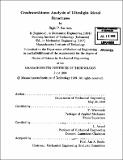| dc.contributor.advisor | T. Wierzbicki. | en_US |
| dc.contributor.author | Santosa, Sigit P | en_US |
| dc.date.accessioned | 2005-08-22T18:15:33Z | |
| dc.date.available | 2005-08-22T18:15:33Z | |
| dc.date.copyright | 1999 | en_US |
| dc.date.issued | 1999 | en_US |
| dc.identifier.uri | http://hdl.handle.net/1721.1/9424 | |
| dc.description | Thesis (Sc.D.)--Massachusetts Institute of Technology, Dept. of Mechanical Engineering, 1999. | en_US |
| dc.description | Includes bibliographical references (leaves 228-237). | en_US |
| dc.description.abstract | In the design of light weight crashworthy metal structures, thin-walled prismatic components have been widely used in aircraft, high speed trains, fast ships, and automobiles. Two new types of such components are proposed, both of which consist of a thin-walled member and an ultralight metal core such as an aluminum honeycomb or a closed-cell aluminum foam. The first type is the thin-walled member filled wit.h the ultralight metal core, while the second type is a double-walled member with the ultralight metal core sandwiched between the two walls. This research is to study the crushing behavior of the ultralight metal core and to determine the crashworthiness and the weight saving of structures composed of the two types of reinforced components, each of which may undergo axial crushing, bending, or twisting. Numerical expressions are developed to predict the crushing behavior of the new type components. The first task of the research is to study the crushing behavior of closed-cell aluminum foams. A new model of a truncated cube, which captures the basic folding mechanism of an array of cells, is developed. The model consists of a system of collapsing cruciform and pyramidal sections. Theoretical analysis is based on energy consideration in conjunction with the minimum postulate in plasticity. The assumed kinematic model for the crushing mechanism of truncated cube cells gives a good agreement with the deformation mechanism obtained from the numerical simulation. Analytical formulation for the crushing resistance of the truncated cube cell is shown to correlate very accurately with the numerical results. Closed form solutions for the crushing resistance of closed-cell aluminum foams in terms of relative density are developed. The formulas are compared with the experimental results and give an excellent agreement. The double-walled sandwich columns appear to have the highest specific crushing resistance. It is found that during progressive crushing, the core-face plate debonding occurs only at the corner portion of the column, while the web portion remains intact and dissipates most of the work. In the case of filled columns, significant increase of the mean crushing force is also obtained by filling the thin-walled columns with aluminum foam. It is found that the increase of the mean crushing force of a foam-filled column has a linear dependence on the foam compressive resistance and cross sectional area of the column, with a proportionality constant equal to 1.8. The proposed solution is well correlated with the experimental data for wide range of column geometries, materials, and foam strengths. The ultralight metal filler also provides a higher bending resistance by retarding inward fold formation at the compression flange. In the case of aluminum foam filling, the presence of the foam filler changes the crushing mode from single stationary fold to a multiple propagating fold. The progressive crushing prevents the drop in load carrying capacity due to sectional collapse. This phenomenon is captured by both experiment and numerical simulation. Partially foam-filled beams offer nearly as high bending resistance as fully filled beam. The concept of the effective foam length is developed. Two distinct crushing states are observed in the torsional deformation of filled thin-walled bars, namely the initial torsional resistance and the stabilized torsional crushing mechanisms. The ultralight metal filler provides a stabilizing effect on the torsional crushing process. The inward fold collapse of the column wall is restricted due to the filler, and the plastic resisting mechanism is increased through the formation of outward-diagonal shear bands. The structural weight saving is assessed through a concept of specific energy absorption, defined as the work absorbed divided by the total component weight. The filled and double-walled sandwich members give higher specific energy absorption than the empty thin-walled member. A 40 - 100 % weight saving can be achieved by the double-walled sandwich components, while 25 - 70 % weight saving can be achieved by filled thin-walled components. It is proven that the proposed components are attractive structural elements for weight-efficient crashworthy design. | en_US |
| dc.description.statementofresponsibility | by Sigit P. Santosa. | en_US |
| dc.format.extent | 244, [2] leaves | en_US |
| dc.format.extent | 15251910 bytes | |
| dc.format.extent | 15251666 bytes | |
| dc.format.mimetype | application/pdf | |
| dc.format.mimetype | application/pdf | |
| dc.language.iso | eng | en_US |
| dc.publisher | Massachusetts Institute of Technology | en_US |
| dc.rights | M.I.T. theses are protected by copyright. They may be viewed from this source for any purpose, but reproduction or distribution in any format is prohibited without written permission. See provided URL for inquiries about permission. | en_US |
| dc.rights.uri | http://dspace.mit.edu/handle/1721.1/7582 | |
| dc.subject | Mechanical Engineering | en_US |
| dc.title | Crashworthiness analysis of ultralight metal structures | en_US |
| dc.type | Thesis | en_US |
| dc.description.degree | Sc.D. | en_US |
| dc.contributor.department | Massachusetts Institute of Technology. Department of Mechanical Engineering | en_US |
| dc.identifier.oclc | 43324162 | en_US |

